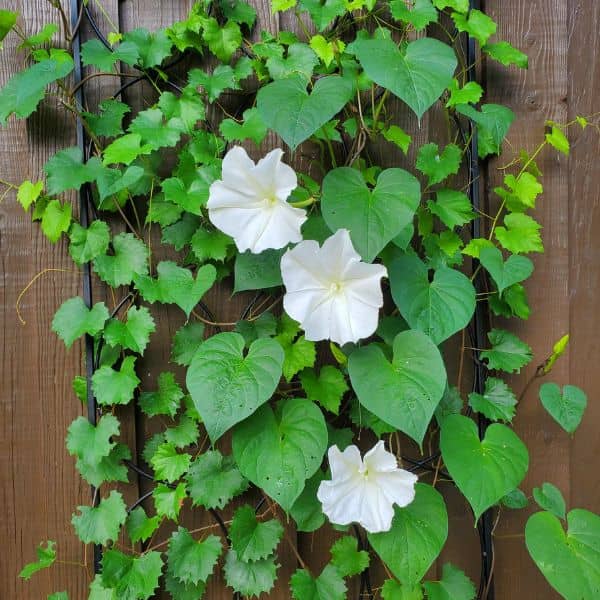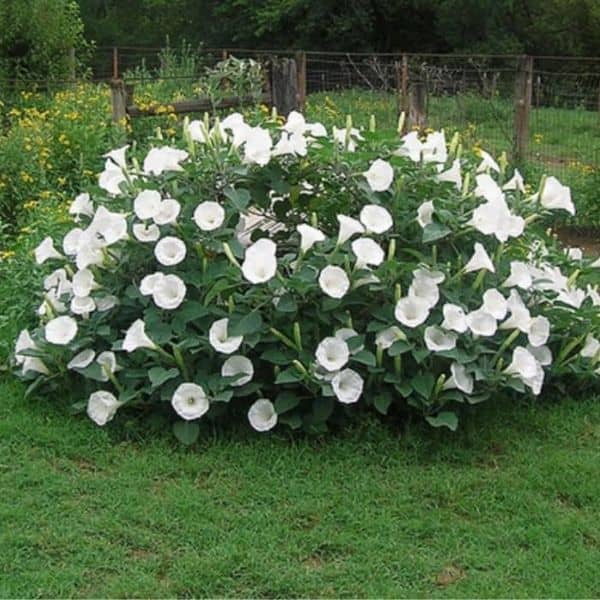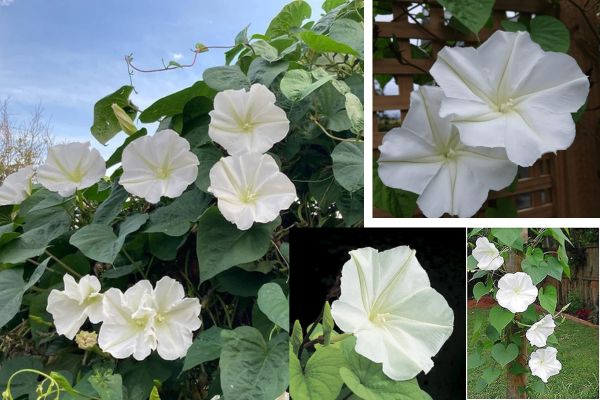If you are new The process of growing your own Moonflower Vine could be enjoyable. Moonflowers, scientifically known as Ipomoea alba a perennial plant that reaches a height of 5-30m. It has heart-shaped big dark green leaves which produce white or pink flowers.
Here we provide you the detailed information on how you can grow Moonflower Vine.
Understanding Moonflower Vine:
The Moonflower Vine scientifically named Ipomoea alba, also known as moon vine or moonflower morning glory is a fast-growing indigenous to tropical and subtropical areas of the Americas. Also, it is popular for its bloom at night, opens its pure white blossoms to the light of the moon, and gives a strong scent that attracts both pollinators and people.
These plants normally reach a height of 8 to 20 feet in just one growing season as this is one of the fastest growing plants. The beautiful moonflower vine looks even better with its large, heart-shaped leaves. Moonflower is relatively considered as low maintenance plant with proper care and maintenance.

Growing Moonflower Vine will add an appearance of daylight beauty to your garden or environment. Listed below is a step-by-step easy method for growing moonflower vines-
1. Select the Proper Location-
Moonflower Vine’s proper development and flowering depends upon the correct location you choose. Moonflowers thrive in full sun, so it is better to place them in a location that receives good sunlight, it can also adjust in partial shade but might not flower.
2. Preparing the Soil-
Many types of soil are acceptable for this vine, however, it prefers rich, sandy soil, that drains well and has a pH that is between slightly acidic and neutral. Make sure that the soil is well-drained and rich in organic compost, you can add compost or old waste to the soil to improve the fertility and its texture.
3. Watering-
As moonflower vine prefers a moderate level of soil moisture, keep the soil moist mainly during dry days or more heat. Water fresh plants often to keep their soil moist but not too wet, as it may cause root rot.
The moonflower vine dies fast in direct sunlight without a regular supply of water and requires continuously damp soil, but if given enough water, it immediately grows again.
4. Fertilizing Your Plant-
To maintain good development and lots of blooms, a balanced fertilizer should be applied every 4-6 weeks during the growing season. It is necessary to use a fertilizer that is rich in phosphorus while planting moonflower vines in pots. During summer fertilize once a month.
When should we plant Moonflower Vine?
Moonflower Vine is best planted in most areas in the Spring, as it is the time when the possibility of cold has gone, and the soil has warmed. However, if you live in colder areas, you should wait to plant moonflower seeds directly into the garden, and only plant the seeds when the frost has ended, and the soil temperature is at least 60°F.
When you decide the plant the Moonflower, make sure the area has full sun and well-draining soil, requiring enough sunlight to grow and bloom healthy, as they do grow well in warm and sunny environments.
How to Grow Moonflower from the Seed?
To grow the moonflower from the seed, first, you need to clip the seed a little bit using a nail clipper or filler to get some of the brown coatings off, make sure that you don’t cut all the seed in half.
After getting all your seeds coated, move them into the warm water for 24 hours, as it will help to soften the seed coat and help in germination.
Next day, take the seeds out of the water, and plant them in the garden or also in containers.

Propagating Moonflower?
It is quite simple to increase the number of plants by simply relocating the volunteers that grow from the seeds that are planted in your yard.
- Check for the small seedlings in the garden that have just started to grow, where the mature plants of the previous year left their seeds, these will often grow in spring.
- Find the seedling carefully and move it to a new spot using a small garden shovel.
- If you are propagating late in the season, you can bring the plants outdoors in the spring after they have grown indoors during the winter in small individual pots.
- Potted indoor seedlings will need a little support to hold this flower as they grow quickly.
Common Problem on Moonflower Vine-
1. Pests and Fungal Disease:

Moonflowers may face pests including aphids, spiders, or whiteflies, as these plants can damage the leaves, lead to slow growth, and interfere with flowering. It can be managed with the use of neem oil and insect-repellent soap. This vine also is vulnerable to fungi-related illnesses including leaf spots, and powdery mildew which causes yellowing or browning of the leaves, and leaf spots.
2. Nutrient Deficiency-
Nutrient Deficiency can be another major issue found in Moonflower Vine, a balanced fertilizer should be given on a regular basis can help plants get the important nutrients to grow and bloom, whereas, if the plant has not been given proper nutrients then it can cause in yellowing of leaf, slow development of the plant, and reduce in blooming.
3. Root Rot-
Another common problem in Moonflower Vine is Root Rot causing yellowing or dying of the leaves. It can also be caused due to overwatering or poorly draining soil. Ensure that the soul drains properly, and let it dry out a bit while watering to avoid the root rot. Dont overwater your plant and remove the dead or damaged leaves in order the stop the disease from spreading.
FAQs
1. Can Moonflowers be grown in pots?
Yes, you can plant Moonflowers in pots or containers, following the same method as while planting in the garden, providing support for upright growth like a trellis.
2. Does the Moonflower vine only give white flowers?
Yes, Moonflower Vine/Ipomoea alba mainly produces white flowers.
3. How much sunlight does the moonflower vine need?
Moonflowers require full sun direct sunlight each day for healthy growth and bloom quickly, while it can also tolerate some partial shade it might reduce its blooming.
You may like to read, 10 Houseplants That Are Perfect For Your Kitchen!
